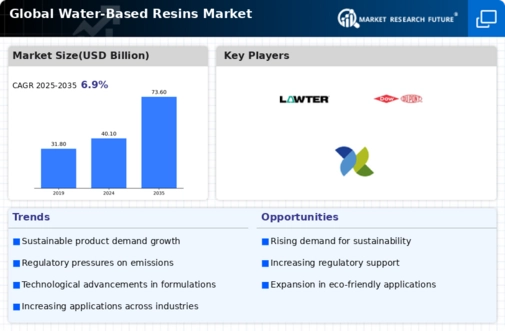Market Share
Water-Based Resins Market Share Analysis
In the competitive landscape of the Water-Based Resins Market, businesses employ various strategic approaches to secure their market share. One prevalent strategy revolves around product differentiation. Companies aim to distinguish their water-based resin products by emphasizing unique features, such as enhanced durability, eco-friendliness, or specific application advantages. By highlighting these distinctive attributes, they seek to capture the attention of niche markets or specific customer segments.
Another pivotal approach involves pricing strategies. Some players opt for competitive pricing, offering their water-based resins at rates more attractive than their rivals. This tactic aims to allure price-sensitive customers and gain traction in markets where cost plays a significant role in purchasing decisions. Conversely, premium pricing strategies are adopted by companies emphasizing superior quality or specialized applications of their water-based resins, targeting customers who prioritize value over price.
Market penetration strategies are also widely utilized. Companies actively seek to expand their market share by intensifying their presence in existing markets. This can involve aggressive marketing campaigns, distribution network enhancements, or even offering incentives to encourage customers to switch from competitors' products to their own. By focusing on increasing sales within established markets, businesses aim to solidify their foothold and potentially gain dominance.
Furthermore, innovation remains a key driver in the Water-Based Resins Market. Companies invest in research and development to introduce advanced formulations, improved functionalities, or environmentally sustainable alternatives. By staying at the forefront of technological advancements, businesses can attract customers seeking innovative solutions and gain a competitive edge, thereby enhancing their market share.
Collaboration and strategic partnerships also play a significant role in market share positioning. Companies often form alliances with suppliers, distributors, or even complementary businesses to leverage each other's strengths, expand market reach, or access new customer segments. Such collaborations can amplify market penetration efforts and accelerate growth by tapping into shared resources and expertise.
Moreover, geographical expansion strategies are vital in capturing additional market share. Companies may focus on entering new regions or countries by understanding local preferences, regulations, and market dynamics. Adapting products and marketing strategies to fit the unique demands of these new markets helps in establishing a presence and gaining market share in previously untapped areas.






Leave a Comment